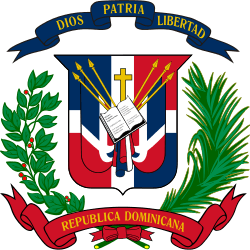Women in the Dominican Republic
 Mirabal sisters, symbols of Dominican feminist resistance. | |
| Gender Inequality Index[1] | |
|---|---|
| Value | 0.505 (2013) |
| Rank | 105th out of 152 |
| Maternal mortality (per 100,000) | 150 (2010) |
| Women in parliament | 19.1% (2013) |
| Females over 25 with secondary education | 55.6% (2012) |
| Women in labour force | 51.2% (2012) |
| Global Gender Gap Index[2] | |
| Value | 0.6867 (2013) |
| Rank | 72nd out of 136 |
Women in the Dominican Republic are women who live in or are from the Dominican Republic. Their character has been defined by their history, culture, tradition and experience.
Character
Constitutionally, the modern-day women of the Dominican Republic are equal to men in terms of rights and property ownership.[3] Culturally, the women of the Dominican Republic have an attitude that is known as machista behavior, where women understood and to a certain degree accepted the machismo nature of Dominican Republic men. By tradition, Dominican Republic women are expected to be submissive housewives, whose role in the household include child bearing and rearing, taking care of and supporting their husbands, cooking meals, cleaning the house,[4] and sewing.[5]
Role at work
Women in the Dominican Republic are often the breadwinners for their households. Dominican Republic women are the majority in the workforce of the country that is currently the 4th largest location of free trade zones in the world. The average salary of a working woman in the Dominican Republic in 1990 was at US$59.00. In rural areas, it was easier for women to find jobs, where they are paid less.[6] Many women from the Dominican Republic migrated to New York City in the United States in order to escape from the "male-dominate culture" of Dominican Republic society.[5] One notable example of literature depicting the struggles of women in the Dominican Republic and their yearning for better life through education is Julia Alvarez's historical novel titled In the Time of the Butterflies, whose heroine Minerva Mirabal lived in the Dominican Republic during the reign of Rafael Trujillo.[3]
Status in society

Women of the Dominican Republic who belong to the lower-class live in families that have a matriarchal structure, often because the father is not at home. While among women who belong to the middle and upper-classes exist in families with patriarchal structures.[6]
Ethics and etiquette
Women in the Dominican Republic are characteristically polite, they give importance to personal appearance, neatness and cleanliness. In the rural areas, Dominican Republic women may wear dresses and skirts; while in urban locations, Dominican Republic women may prefer to wear short skirts and jeans. The clothing in both areas may be made up of bright coloration and shiny fabrics. Older or prominent women are often addressed as Doña followed by their surnames as a form of respect. Female greetings may involve women kissing each other on both cheeks.[6]
In relation to riding motorcycles, it is customary for Dominican Republic women to sidesaddle while on the backs of such vehicles; the reason is that it is "unladylike" to sit while the legs are apart.[6]
Life expectancy
Women in the Dominican Republic have an average life expectancy of 72 years.[6]
Arts and crafts
Women who live in the rural areas of the Dominican Republic usually engage themselves in the manufacture of macramé hammocks, bags, baskets, products of palm weaving, and the creation of jewelry using coral, seashells, amber, and the semiprecious ocean-blue gemstone known as larimar (a gemstone that is native only in the country).[6]
References
- ↑ "Table 4: Gender Inequality Index". United Nations Development Programme. Retrieved 7 November 2014.
- ↑ "The Global Gender Gap Report 2013" (PDF). World Economic Forum. pp. 12–13.
- ↑ 3.0 3.1 "Roles of Women in the Dominican Republic" (PDF). THE BIG READ. National Endowment for the Arts. Retrieved 24 October 2013.
- ↑ "Machismo and the Dominican Republic". dr1.com. Retrieved 24 October 2013.
- ↑ 5.0 5.1 Elzeftawy, Sara. "The Role of Dominican Women Before and After". City University of New York Foundation. Retrieved 24 October 2013.
- ↑ 6.0 6.1 6.2 6.3 6.4 6.5 Van Epsgarlo, Elizabeth. "Dominican Republic". Advameg, Inc. Retrieved 24 October 2013.
External links
| Wikimedia Commons has media related to Women of the Dominican Republic. |
| ||||||||||
| |||||||||||||||||||||||||||||||||||||||||

